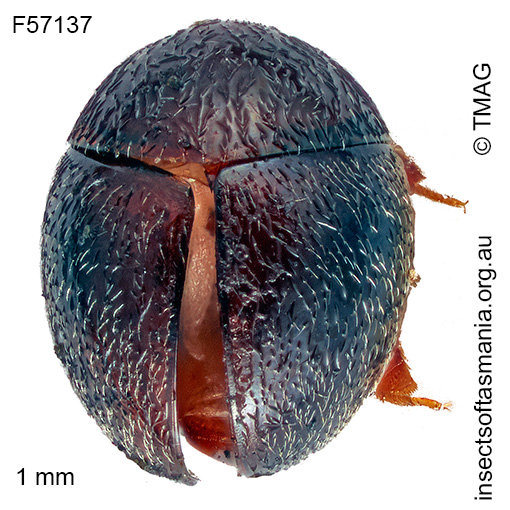
Globorentonium globulum (a species of rentoniid beetle)
Basis for Tasmanian occurrence
Lawrence, J.F. & Ślipiński, A. (2013) Globorentonium, a new genus of rentoniine Trogossitidae (Coleoptera: Cleroidea) from Australia and Brazil. Zootaxa 3710 (3): 257-270. (as Globorentonium globulum)
TMAG collections
Classification
Order: Coleoptera
Suborder: Polyphaga
Superfamily: Cleroidea
Family: Rentoniidae
Morphology
Typical length (mm): 1.2
Flightedness: winged and assumed capable of flight
Source literature on morphology and taxonomy (*primary taxonomic source, where identified):
*Lawrence, J.F. & Ślipiński, A. (2013) Globorentonium, a new genus of rentoniine Trogossitidae (Coleoptera: Cleroidea) from Australia and Brazil. Zootaxa 3710 (3): 257-270.
Ecology
Assumed larval feeding: predator
Association with dead wood or old trees: obligately saproxylic
Ecological attributes: — May occupy logs or trunks of Eucalyptus obliqua, at least temporarily, since found having emerged within a year of felling (Grove & Bashford, 2003) — May occupy logs or trunks of Eucalyptus obliqua, at least temporarily, since found having emerged within six years of felling (Grove et al., 2009).
Collection method(s) for TMAG material: — Emergence trapping from log of Eucalyptus obliqua — Log-mounted flight intercept trapping — Pitfall trapping.
Source ecological literature:
Grove, S.J. & Bashford, R. (2003). Beetle assemblages from the Warra log decay project: insights from the first year of sampling. Tasforests 14: 117-129.
Baker, S.C. (2000). Forest litter beetles and their habitat: a comparison of forest regenerated by wildfire and logging practices. Hons. thesis, Univ. of Tasmania, Hobart.
Baker, S.C. (2006b). Ecology and conservation of ground-dwelling beetles in managed wet eucalypt forest: edge and riparian effects. PhD thesis, Univ. of Tasmania, Hobart.
Grove, S. et al. (2009). A long-term experimental study of saproxylic beetle … succession in Tasmanian Eucalyptus … logs… In: Fattorini, S. (Ed.), Insect Ecology and Conservation. Research Signpost, pp. 71-114.

